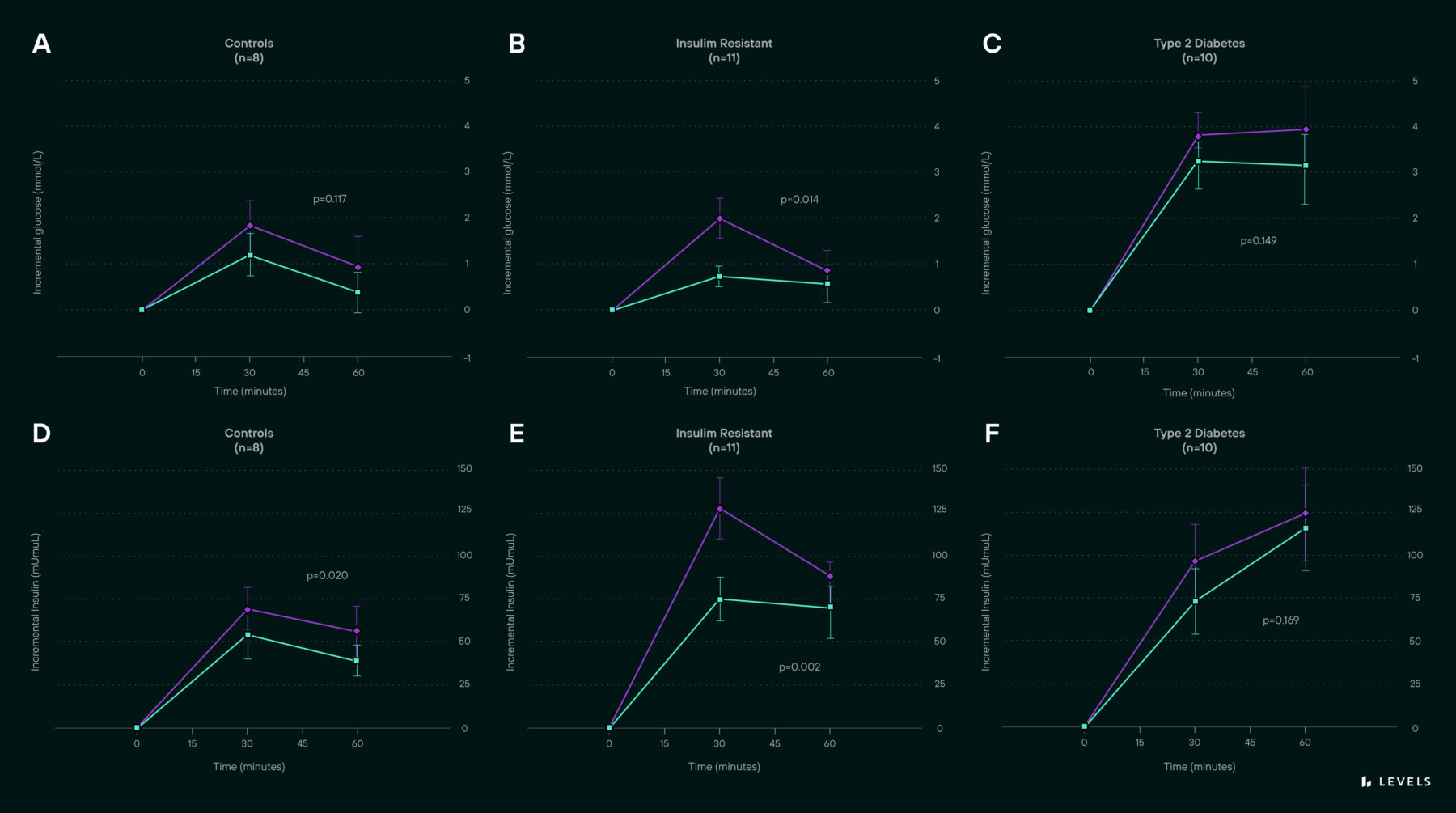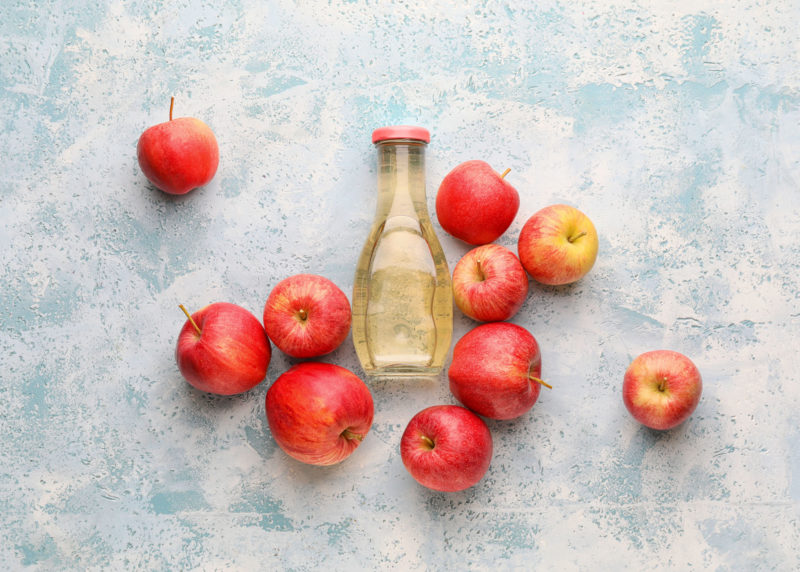Apple cider vinegar (or ACV) has been used for thousands of years as a food flavoring, preservative, and therapeutic tool for healing wounds, fighting infections, managing diabetes, and more. Recently, a growing body of research supports the health-boosting potential of consuming this tangy condiment—particularly for supporting stable blood glucose.
Apples naturally contain yeasts and sugars, and both are key to vinegar production. ACV is made from the liquid of crushed apples via a two-step fermentation process. In the first step, the yeasts ferment the sugars into ethanol, essentially creating hard cider. Then, in a secondary fermentation process, naturally occurring acetic acid bacteria that survived the initial fermentation oxidize ethanol into acetic acid, creating vinegar.
Apple cider vinegar retains a faint apple-like flavor with a tangy-pungent twist that some people consider an acquired taste. Raw, unpasteurized ACV is also known for containing “the mother”—a slimy film composed of yeast and acetic acid bacteria. At this point, it’s unclear if the mother provides significant levels of beneficial bacteria that function as probiotics but rest assured, it’s completely harmless.
A tablespoon of ACV contains negligible calories, carbs, fiber, and protein; trace levels of minerals; and different polyphenols depending on the type of apple and processing technique. But something that pops up in research time and again as the basis for ACV’s metabolic health benefits is the compound that lends vinegar its tangy kick: acetic acid.
Before we dive into the research on ACV, keep in mind, all vinegar contains acetic acid, so many of the metabolic benefits mentioned below apply to vinegar across the board. However, many people prefer the flavor of ACV over other vinegars.
Metabolic Health Benefits of Apple Cider Vinegar
Preliminary research suggests that apple cider vinegar may support metabolic health on multiple fronts, from improving blood glucose control and lowering cholesterol levels to promoting modest weight loss. While we don’t yet have large randomized control trials, ACV’s impact on blood glucose appears particularly promising.
Consuming ACV at the start of a carb-rich meal may help blunt post-meal blood sugar spikes. In a small study, participants with normal insulin sensitivity, insulin resistance, or Type 2 diabetes consumed a beverage containing either four teaspoons of ACV or a placebo two minutes before eating a buttered bagel with orange juice. In the hour following the meal, the ACV drinkers saw a 19 to 34 percent improvement in insulin sensitivity and reduced post-meal glucose and insulin, with the most significant effect in the insulin-resistant group.

Effects of vinegar (□) and placebo (⧫) on plasma glucose (A–C) and insulin (D–F) responses after a standard meal in control subjects, insulin-resistant subjects, and subjects with type 2 diabetes. Values are means ± SE. The P values represent a significant effect of treatment (multivariate ANOVA repeated-measures test). Source
Similarly, a study consisting of four different trials on vinegar’s impact on blood glucose found that, on average, consuming two teaspoons of vinegar (either ACV or red raspberry vinegar) two minutes before a high-carb meal curbed post-meal blood glucose by 20 percent in people with and without diabetes. But no such effect was found when the vinegar was consumed five hours before the meal, suggesting that the proximity of vinegar to the meal matters.
Results from a meta-analysis of nine clinical trials involving 686 participants also concluded that regular consumption of ACV reduced total cholesterol, fasting blood glucose, and HbA1c, a metric that represents a three-month average of glucose levels in the blood. However, researchers found that the glucose-lowering effect wasn’t significant in people without diabetes, and more research is needed to determine an optimal dose.
So how, exactly, might ACV improve glycemic control? Acetic acid appears to be the driver of these benefits, and it may operate via several potential mechanisms:
- Acetic acid may help suppress activity of disaccharidases, enzymes in the small intestine that break down carbs into simpler sugars that can be absorbed into the bloodstream. Suppressed enzyme activity, in turn, reduces the absorption of these carbs (as sugar) and lessens the blood sugar spike you see after eating a high-carb meal.
- Acetic acid may enhance glucose uptake from the bloodstream by skeletal muscle cells—so less glucose remains circulating in the bloodstream. Researchers believe this has to do with improved insulin sensitivity in skeletal muscle.
- Acetic acid may delay gastric emptying, or the movement of food out of the stomach and into the small intestine, where glucose is absorbed. This delay slows the breakdown of carbs and the subsequent glucose absorption, thus buffering blood sugar elevations.
But blood glucose control isn’t the only way ACV supports metabolic health. It appears to support healthy blood lipids and cholesterol too. High triglycerides and low HDL are both factors in metabolic syndrome, and high LDL may promote the buildup of dangerous plaque in blood vessels. However, while scientific results in this area are somewhat mixed, the meta-analysis mentioned above suggests that ACV consumption is associated with reduced total cholesterol. And several animal studies demonstrate that regular vinegar intake may lower LDL cholesterol and triglycerides and increase HDL cholesterol. This may result from acetic acid’s ability to activate the enzyme AMP-activated protein kinase (AMPK), which inhibits cholesterol and fatty acid synthesis.
Apple cider vinegar also may have a modest effect on weight. In a double-blind, placebo-controlled trial of 175 obese but otherwise healthy Japanese adults, those who consumed two tablespoons of ACV diluted in water after meals each day lost an average of four pounds by the end of the 12-week study period, and those who consumed a one-tablespoon dose lost an average of 2.6 pounds. Researchers believe this weight loss may be a result of reduced fatty acid synthesis and increased fatty acid oxidation (or fat burning) triggered by activation of AMPK by acetic acid. Apple cider vinegar may also contribute to reduced appetite, which could promote weight loss due to reduced food intake. However, research is relatively limited in this space (particularly on humans), and more large-scale, long-term clinical trials on ACV and weight loss are needed to quantify its true benefit.
ACV may also help with some of the physiological consequences of being overweight. An animal study on obese rats fed a high-fat diet found that ACV consumption helped suppress obesity-induced oxidative stress—a process that contributes to the cellular damage that underlies metabolic dysfunction—in part by increasing the activity of antioxidant enzymes in the body such as glutathione peroxidase. In another study, diabetic rats that consumed ACV also experienced increased antioxidant enzymes.
Lastly, raw apple cider vinegar with the “mother” may contain several species of live bacteria from the fermentation process, including strains of Acetobacter, Komagataeibacter, Gluconobacter, Lactobacillus, and Oenococcus species. Unfortunately, except for the Lactobacillus species, these bacteria aren’t well studied, so it’s unclear if they function as probiotics or contribute to any meaningful health benefits. The level and type of bacteria present in ACV also varies based on the varieties of apples used and processing techniques, making it difficult to define the microbial composition of ACV.

Does vinegar really lower blood sugar?
Why would a shot of vinegar blunt the glucose spike from a carb-heavy meal? Here's what the research shows, and tips for working vinegar into your diet.
Read the ArticleHow To Buy Apple Cider Vinegar?
Not all products categorized as apple cider vinegar may offer the same benefits. Follow these tips for buying, storing, and using ACV to reap the maximum benefits.
- Always opt for real apple cider vinegar over apple cider vinegar gummies or tablets to reap the fullest blood sugar benefits. One small study examining the effects of consuming liquid apple cider vinegar or apple cider vinegar tablets at the start of a meal found that the liquid ACV resulted in a 31 percent greater reduction in post-meal blood glucose spikes than the tablets. Plus, most ACV gummies contain added sugars (around one gram per gummy), which is counterproductive for blood sugar management.
- Choose raw (unpasteurized) and unfiltered apple cider vinegar with the mother. While all apple cider vinegar contains acetic acid—the key health-promoting compound in vinegar—only raw ACV contains naturally occurring, potentially beneficial bacteria from the fermentation process, such as Acetobacter, Komagataeibacter, and Gluconobacter.
- Select organic apple cider vinegar when possible. (Fortunately, most raw and unfiltered ACV is also organic.) Not only do organic products contain less pesticide residue than their conventional counterparts, but research also suggests that organic ACV may contain a greater diversity of live bacteria as well. Consider one of these organic, raw, and unfiltered ACV brands: Bragg, Spectrum Organic, or 365 by Whole Foods Market.
- Store raw, unfiltered apple cider vinegar in a cool, dark place such as a kitchen cabinet or the refrigerator, and keep the cap sealed tightly to maintain optimal flavor and freshness. Once opened, apple cider vinegar may last a year or potentially much longer when stored correctly. Vinegars are considered self-preserving products thanks to their high acid content, which kills unwanted pathogens. You may notice aesthetic changes after opening your ACV, like cloudiness or growth of the mother, but this is harmless.
How Do You Take Apple Cider Vinegar?
- Always dilute apple cider vinegar or use it in a recipe. Given ACV’s acidity, it could damage your esophagus and erode tooth enamel when consumed straight, as demonstrated in several case studies. As a general rule, dilute every one tablespoon of ACV with at least one cup of water.
- Most research suggests that consuming diluted ACV shortly before a meal could offer the greatest results in terms of glycemic control, weight loss, and improved blood lipid levels. But keep in mind, the optimal dose of ACV for various health benefits has not been established, and most human studies have not exceeded two tablespoons per day.
- Apple cider vinegar may be consumed cool or warm. Acetic acid appears to be responsible for most of ACV’s known health benefits, and it breaks down around 446°F—so it would be unaffected when combined with recently boiled water (212°F). Heat may kill some of the potentially beneficial bacteria, but the extent to which these bacteria may impact health is unknown.
Ideas For Using Apple Cider Vinegar
There are many ways to enjoy apple cider vinegar beyond just salad dressing (although that’s great too). Here are some simple ways to incorporate a few tablespoons into your day:
- Healthy salad dressing. Combine three parts olive oil or avocado oil with one part apple cider vinegar, along with flavor-boosters such as Dijon mustard and garlic to taste. Or try Primal Kitchen’s Green Goddess Dressing & Marinade, a clean, store-bought option featuring ACV, avocado oil, and zero grams of sugar.
- Pre-meal beverage. Stir a tablespoon of ACV into one cup of water (cold water, warm water, or even tea) and drink this mixture at the beginning of meals to curb post-meal blood sugar spikes. If you’re not a fan of the flavor, get creative with sugar-free add-ins such as lemon, cinnamon, ginger, and cayenne. Try this spicy ACV tonic with ginger and cinnamon from Max Lugavere, author of Genius Foods.
- Cocktail replacement. ACV has a nice kick and robust flavor that some consider a satisfying substitute for boozy cocktails. Make an ACV spritzer by combining one to two tablespoons of ACV with one cup of plain seltzer, a squeeze of lemon, muddled berries, mint or basil leaves, and plenty of ice.
- Smoothie add-in. Add one to two tablespoons of ACV to your next smoothie for a tangy kick and added health benefits. Try this refreshing green smoothie recipe from Dr. Taz Bhatia, MD, featuring ACV and blood-sugar stabilizing fiber and healthy fats from avocado, kale, cucumber, apple, and more.
- Quick pickled veggies. Traditional pickling takes time, but you can make quick-pickled veggies (a.k.a. refrigerator pickles) in a few days with apple cider vinegar, water, and salt. Almost any veggie can be pickled with ACV. Try green beans, sliced cucumbers, cherry tomatoes, and sliced carrots. Follow this straightforward, quick pickle tutorial.
- Savory sauces. Add nuance and depth of flavor to DIY savory sauces with a splash of ACV. Try this creamy, nutty sauce made with sunflowers and flax seeds, liquid aminos or tamari, chili powder, and garlic. Drizzle on roasted vegetables or veggie burgers.







